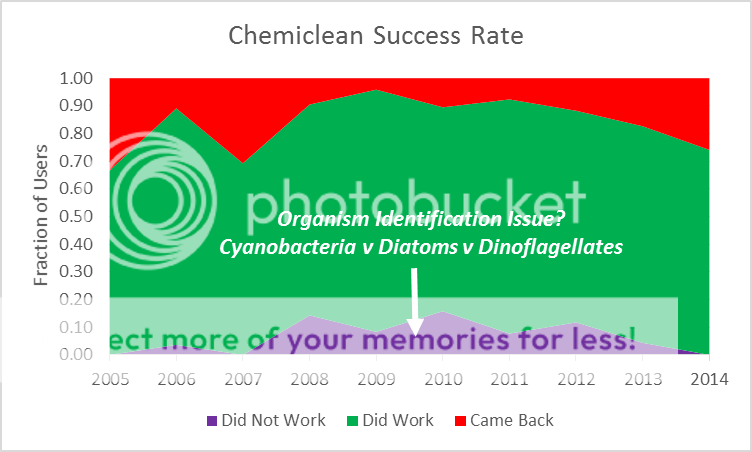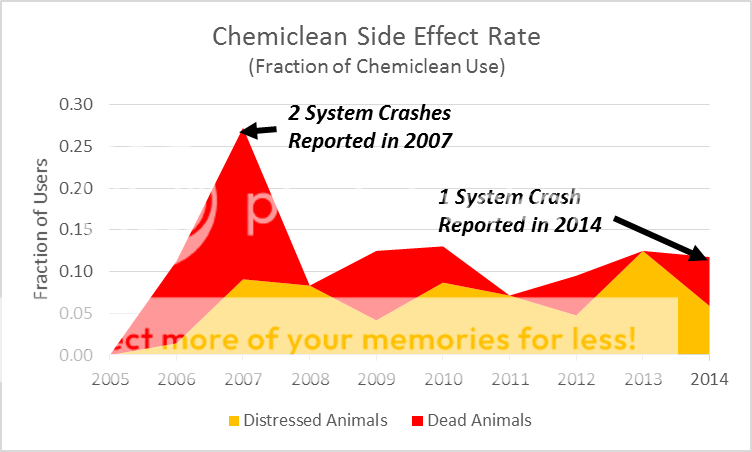- Location
- Connecticut
This is a report on the survey of 500 Reef Central threads mentioning Chemiclean, the cyanobacteria remedy. Only one report of Chemiclean use was recorded per forum member to avoid double counting more active forum members. Threads on this topic became numerous after 2005.
What is Chemclean? The active ingredient was reported by RC forum member Boomer in 2009 to be erythromycin cetyl sulfate
http://www.reefcentral.com/forums/s...&highlight=erythromycin+cetyl+sulfate&page=25
The product I recently purchased is a fine pale yellow powder that gives a pale yellow solution when one scoop is dissolved in 1 ml of tap water. The Chemiclean solution conductivity was greater than tap water, indicating an ionic soultion. Viewed under the microscope, the powder consists mostly of spherically shaped solids, suggestive of a granulated material.
http://i1028.photobucket.com/albums/y349/Drfungus137/Chemiclean_zps00844583.jpg
Granulation is a technique of blending powders with a small amount of water to produce tiny granuales, making tablet manufacturing easier and to make tablets with the required characterisics. Chemiclean dissolves in water and 91% isopropanol. When dumped on top of tap water, it floats and then turns into a thick syrupy mass that takes some time to dissolve, supporting the microscopic analysis that the material is a noncrystalline solid.
Chemiclean is dosed at a rate of one scoop per 10 gallons of water. This works out to be 67 mg per dose and a concentration of ~2 ppm assuming 100% active ingredient. The amount of active ingredient per dose is not known but it provides a high enough concentration of the surfactant counter ion cetyl sulfate to cause severe foaming with aeration. As reported by forum members, the protein skimmer can be out of commission for more than a week because of excessive foaming. Even at a one tenth dose, there is substantially more foaming than aquarium water (see demonstration on YouTube)
https://www.youtube.com/watch?v=un6NtZEQkxw&feature=youtu.be
Removing the active ingredient by water change is not practical and requires another approach. With the skimmer being out of commission because of excess foaming, this leaves GAC as the only option. One gram of granular activated carbon can absorb 3.8 mg sodium dodecyl sulphate (SDS), a closely related surfactant used in cosmetics and toothpaste. Assuming sodium cetyl sulfate is similarly adsorbed, every 10 gallons of water treated requires roughly 9 grams of GAC (calculatiuon is based on the cetyl sulfate making up about half the weight of the active ingredient and assuming 100% active ingredient).
How well does Chemclean work? The first plot below shows the success rate for Chemiclean use reported by forum members over the years. It is not clear though how long the cyanobacteria were kept in check when a forum member reported that Chemiclean "worked". Many failures of Chemiclean are likely a result of identifying diatoms and dinoflagellates as cyanobacteria. Similarly, when cyanobacteria is reported to have come back after treatment, this rebloom could be a different organism. There is no information about how well the Chemiclean instructions were followed nor is it known whether the potency varied lot to lot or whether the formulation strength changed over the years.
When I placed a piece of cyanobacteria mat into a small container of aquarium water containing a dose of Chemiclean, the mat seemed to shrink or shrivel over time (see time lapse video on YouTube).
https://www.youtube.com/watch?v=gzadG03qed4&feature=youtu.be
Several days later, however, a new film of cyanobacteria had started to grow from the shrunken mat. I did not run a control, so, the shrinking might not have been Chemiclean related.. The regrowth might have occurred because the ratio of Chemiclean to mass of cyanobacteria was too low.
The side effect rate, distress and death, are reported in the second plot. There was speculation around the 2007 timeframe by forum members that a bad lot of Chemiclean which had a brownish appearance might have been associated with the tank crashes. In one case, the forum member reported mistakenly overdosing the system leading to a heavy loss of animals. Based on experience following the 2007 peak, there still remains a substantial risk of stressing or killing some aquarium inhabitants with a Chemiclean treatment.
While the deterimental effect to biofilter bacteria of high erythromycin concentrations has been discussed, little attention has been paid to the potential toxicity of cetyl sulfate in fish, coral, invertabrate and the biofilter. Fish toxicity, altering oxygen absorption and ammonia excretion has been demonstrated for the closely related surfactant SDS. Fish egg toxicity has also been demonstrated. SDS and potentially cetyl sulfate can have detrimental effects on bacteria cell membranes. These effects may account for the reported Chemiclean associated stress and death of aquarium inhabitants that can occur anytime after dosing. These severe side effects might involve ammonia poisoning, arising from a sudden rise in ammonia excretion and/or a rapid decline in ammmonia consumption by the biofilter because of cetyl sulfate and erythromycin poisoning. This side effect might be more likely in aquariums with a heavy bioload or a biofilter heavily populated with Chemiclean sensitive bacteria. For example, if cyanobacteria comprised a significant portion of the biofilter, ammonia levels could be expected to rise faster than the remaining biofilter could consume.
Conclusion. Success at eradicating cyanobacteria with Chemiclean is not guarenteed. The vendor's safety warnings seem to be inadequate in light of this survey. Based on foum member usage reports, the risk of using Chemiclean is probably underestimated and inadequately understood. Still, Chemiclean probably has a place in the saltwater aquarium maintenance, but only with a more complete consideration of side effects.
Sucess Rate

Side Effect Rate

What is Chemclean? The active ingredient was reported by RC forum member Boomer in 2009 to be erythromycin cetyl sulfate
http://www.reefcentral.com/forums/s...&highlight=erythromycin+cetyl+sulfate&page=25
The product I recently purchased is a fine pale yellow powder that gives a pale yellow solution when one scoop is dissolved in 1 ml of tap water. The Chemiclean solution conductivity was greater than tap water, indicating an ionic soultion. Viewed under the microscope, the powder consists mostly of spherically shaped solids, suggestive of a granulated material.
http://i1028.photobucket.com/albums/y349/Drfungus137/Chemiclean_zps00844583.jpg
Granulation is a technique of blending powders with a small amount of water to produce tiny granuales, making tablet manufacturing easier and to make tablets with the required characterisics. Chemiclean dissolves in water and 91% isopropanol. When dumped on top of tap water, it floats and then turns into a thick syrupy mass that takes some time to dissolve, supporting the microscopic analysis that the material is a noncrystalline solid.
Chemiclean is dosed at a rate of one scoop per 10 gallons of water. This works out to be 67 mg per dose and a concentration of ~2 ppm assuming 100% active ingredient. The amount of active ingredient per dose is not known but it provides a high enough concentration of the surfactant counter ion cetyl sulfate to cause severe foaming with aeration. As reported by forum members, the protein skimmer can be out of commission for more than a week because of excessive foaming. Even at a one tenth dose, there is substantially more foaming than aquarium water (see demonstration on YouTube)
https://www.youtube.com/watch?v=un6NtZEQkxw&feature=youtu.be
Removing the active ingredient by water change is not practical and requires another approach. With the skimmer being out of commission because of excess foaming, this leaves GAC as the only option. One gram of granular activated carbon can absorb 3.8 mg sodium dodecyl sulphate (SDS), a closely related surfactant used in cosmetics and toothpaste. Assuming sodium cetyl sulfate is similarly adsorbed, every 10 gallons of water treated requires roughly 9 grams of GAC (calculatiuon is based on the cetyl sulfate making up about half the weight of the active ingredient and assuming 100% active ingredient).
How well does Chemclean work? The first plot below shows the success rate for Chemiclean use reported by forum members over the years. It is not clear though how long the cyanobacteria were kept in check when a forum member reported that Chemiclean "worked". Many failures of Chemiclean are likely a result of identifying diatoms and dinoflagellates as cyanobacteria. Similarly, when cyanobacteria is reported to have come back after treatment, this rebloom could be a different organism. There is no information about how well the Chemiclean instructions were followed nor is it known whether the potency varied lot to lot or whether the formulation strength changed over the years.
When I placed a piece of cyanobacteria mat into a small container of aquarium water containing a dose of Chemiclean, the mat seemed to shrink or shrivel over time (see time lapse video on YouTube).
https://www.youtube.com/watch?v=gzadG03qed4&feature=youtu.be
Several days later, however, a new film of cyanobacteria had started to grow from the shrunken mat. I did not run a control, so, the shrinking might not have been Chemiclean related.. The regrowth might have occurred because the ratio of Chemiclean to mass of cyanobacteria was too low.
The side effect rate, distress and death, are reported in the second plot. There was speculation around the 2007 timeframe by forum members that a bad lot of Chemiclean which had a brownish appearance might have been associated with the tank crashes. In one case, the forum member reported mistakenly overdosing the system leading to a heavy loss of animals. Based on experience following the 2007 peak, there still remains a substantial risk of stressing or killing some aquarium inhabitants with a Chemiclean treatment.
While the deterimental effect to biofilter bacteria of high erythromycin concentrations has been discussed, little attention has been paid to the potential toxicity of cetyl sulfate in fish, coral, invertabrate and the biofilter. Fish toxicity, altering oxygen absorption and ammonia excretion has been demonstrated for the closely related surfactant SDS. Fish egg toxicity has also been demonstrated. SDS and potentially cetyl sulfate can have detrimental effects on bacteria cell membranes. These effects may account for the reported Chemiclean associated stress and death of aquarium inhabitants that can occur anytime after dosing. These severe side effects might involve ammonia poisoning, arising from a sudden rise in ammonia excretion and/or a rapid decline in ammmonia consumption by the biofilter because of cetyl sulfate and erythromycin poisoning. This side effect might be more likely in aquariums with a heavy bioload or a biofilter heavily populated with Chemiclean sensitive bacteria. For example, if cyanobacteria comprised a significant portion of the biofilter, ammonia levels could be expected to rise faster than the remaining biofilter could consume.
Conclusion. Success at eradicating cyanobacteria with Chemiclean is not guarenteed. The vendor's safety warnings seem to be inadequate in light of this survey. Based on foum member usage reports, the risk of using Chemiclean is probably underestimated and inadequately understood. Still, Chemiclean probably has a place in the saltwater aquarium maintenance, but only with a more complete consideration of side effects.
Sucess Rate

Side Effect Rate






